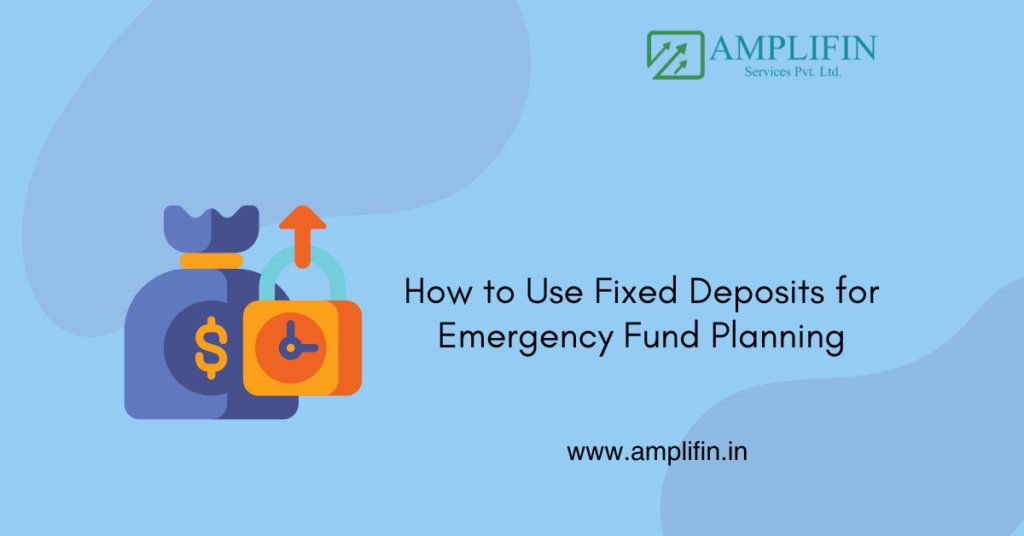Building an Emergency Fund: The Power of Fixed Deposits for Financial Security
An emergency fund is an essential part of your financial planning, offering a cushion against unforeseen expenses like job loss, medical bills, or unexpected home repairs. In this article, we explore how fixed deposits (FDs) can play a crucial role in building a strong emergency fund. Whether you’re just starting to save or looking for better ways to secure your financial future, understanding how fixed deposits fit into your emergency fund strategy will empower you to make informed investment decisions. Read on to learn how you can use fixed deposits for creating an emergency fund and why it’s a low-risk, high-reward option.

Outline:
Why Do You Need an Emergency Fund?
- The importance of having an emergency fund
- How emergencies can disrupt your financial stability
What is an Emergency Fund and How Much Should You Save?
- Defining an emergency fund
- Guidelines on how much to save for unexpected expenses
Why Fixed Deposits Make a Great Emergency Fund Option
- Benefits of using fixed deposits for your emergency savings
- Fixed interest rates and guaranteed returns
How Do Fixed Deposits Offer Liquidity in Times of Need?
- Accessing funds quickly in an emergency
- The role of liquidity in financial security
What Are the Tax Benefits of Using Fixed Deposits for Your Emergency Fund?
- Understanding the tax advantages of fixed deposits
- How Section 80C can help with your tax planning
How to Build an Emergency Fund with Fixed Deposits?
- Step-by-step guide to using fixed deposits to build your emergency fund
- Factors to consider before starting your FD
Should You Invest in Mutual Funds or Fixed Deposits for Your Emergency Fund?
- Comparing the benefits of mutual funds and FDs for emergency savings
- Risk vs. reward in financial planning
What Are the Risks Involved with Fixed Deposits in an Emergency Fund?
- Understanding the potential drawbacks of relying solely on FDs
- Balancing your portfolio with different investment avenues
How High Interest Rates Improve Your Emergency Fund Growth
- Why interest rates matter for emergency savings
- How to maximize returns with fixed deposits
What Other Options Can You Consider for Your Emergency Fund?
- Exploring liquid funds and other low-risk investment options
- Diversification for better financial security
Why Do You Need an Emergency Fund?
An emergency fund is a financial safety net that helps you navigate life’s unexpected turns. Without an emergency fund, you risk having to rely on high-interest debt or loans during a crisis, which can negatively impact your long-term financial stability. Emergencies come in many forms: job loss, medical expenses, urgent home repairs, or other unplanned expenditures. Without savings set aside for these situations, it’s easy to fall into financial distress.
The importance of building an emergency fund cannot be overstated. It serves as a buffer against these unforeseen expenses and gives you peace of mind knowing that you have a safety net in place. Financial advisors recommend saving at least 3-6 months’ worth of living expenses in your emergency fund. This ensures that you are well-prepared for any situation, without having to disrupt your long-term financial goals.
What is an Emergency Fund and How Much Should You Save?
An emergency fund is money that is set aside for life’s unexpected events—things that could derail your normal living expenses. These funds should be easily accessible, and they must cover your essential financial needs such as groceries, utilities, and transportation costs. The ideal amount to save for an emergency fund depends on your personal financial situation, but it’s typically recommended to aim for 3-6 months’ worth of living expenses.
For instance, if your monthly expenses are ₹30,000, you should aim to save between ₹90,000 and ₹1.8 lakh in your emergency fund. This amount gives you enough cushion to weather most financial storms without having to dip into long-term investments or take on high-interest debt. Remember, the goal is to ensure that your emergency fund provides a quick and easy way to cover immediate financial needs.
Why Fixed Deposits Make a Great Emergency Fund Option
Fixed deposits (FDs) offer a low-risk, guaranteed return on your investment, making them an excellent choice for building an emergency fund. Unlike mutual funds or stocks, FDs offer fixed interest rates, ensuring that your money grows predictably over time. This is especially important when you’re saving for emergencies, as you want to ensure your funds grow without the risk of market volatility.
In addition, FDs offer guaranteed returns, meaning you know exactly how much interest you will earn over the term of the deposit. This allows you to plan your financial future with confidence, knowing that your emergency fund is growing steadily. FDs also provide easy access to your money, making them a reliable option when you need quick access to funds in a crisis.
How Do Fixed Deposits Offer Liquidity in Times of Need?
One of the key considerations when building an emergency fund is liquidity—how easily you can access your money in case of an emergency. Fixed deposits offer a great balance of stability and liquidity. While they have a fixed term, most banks allow you to withdraw the money before the term ends, though you may incur a penalty.
This ensures that in times of need, you can quickly access your emergency fund without having to wait for long periods. However, it’s important to ensure that your FD is with a bank that offers flexible withdrawal options. For those looking for immediate access to funds, you can also consider liquid funds, which offer even quicker access while still providing low-risk growth.
What Are the Tax Benefits of Using Fixed Deposits for Your Emergency Fund?
Fixed deposits offer tax benefits under Section 80C of the Income Tax Act in India. If you invest in tax-saving fixed deposits, you can claim deductions of up to ₹1.5 lakh per year, helping you reduce your taxable income. While tax-saving FDs come with a lock-in period, they can still be an attractive option for building an emergency fund, as they offer both tax benefits and guaranteed returns.
In addition to tax-saving FDs, the interest earned on your FD may be subject to tax, depending on your income bracket. It’s crucial to consult with a tax advisor to ensure you understand how to best leverage your FDs in the context of your broader financial planning.
How to Build an Emergency Fund with Fixed Deposits?
Building an emergency fund with fixed deposits is straightforward. First, determine how much you need for your emergency fund, based on your monthly expenses. Next, evaluate the interest rates offered by various banks and choose an FD that aligns with your financial goals. Many banks offer higher interest rates for longer-term deposits, so consider your liquidity needs when selecting the term of your FD.
Once you’ve chosen the right FD, make regular contributions to build your emergency fund over time. Depending on your financial situation, you may choose to set up a monthly SIP (Systematic Investment Plan) to contribute to your FD or make lump-sum deposits. Regularly review your FD and adjust the amount as needed to ensure that your emergency fund continues to grow.
Should You Invest in Mutual Funds or Fixed Deposits for Your Emergency Fund?
While mutual funds can offer higher returns over time, they come with a higher level of risk due to market volatility. For emergency savings, it’s generally safer to opt for fixed deposits, as they provide guaranteed returns and fixed interest rates, giving you peace of mind. However, if you’re looking to grow your emergency fund over the long term, you might consider a combination of fixed deposits and mutual funds, particularly liquid funds, which provide low-risk growth and easy access to funds when needed.
It’s important to assess your risk tolerance and financial goals when making this decision. A well-diversified portfolio that includes both fixed deposits and mutual funds can help balance growth and safety in your emergency fund strategy.
What Are the Risks Involved with Fixed Deposits in an Emergency Fund?
While fixed deposits offer stability and guaranteed returns, they may not be the best option for all types of emergencies. The primary risk of using FDs for an emergency fund is the potential penalty for early withdrawal. If you need to access your funds before the maturity period, you may face a penalty that reduces the interest earned. This makes it essential to carefully consider the term and liquidity of your fixed deposit before using it as part of your emergency fund.
Additionally, fixed deposits are less flexible than savings accounts or liquid funds, which offer quicker access to funds. However, FDs remain a solid choice for those who want to avoid market risks and ensure a stable return on their emergency savings.
How High Interest Rates Improve Your Emergency Fund Growth
One of the advantages of using fixed deposits for your emergency fund is the interest rates. Fixed deposits often offer higher interest rates compared to regular savings accounts, allowing your emergency fund to grow more quickly. By choosing an FD with a higher interest rate, you can accelerate the growth of your savings over time, ensuring that your emergency fund is large enough to cover unexpected expenses.
It’s important to compare the interest rates offered by different banks and choose an FD that maximizes your returns. Some banks may offer special rates for senior citizens or long-term deposits, so be sure to take advantage of any offers that align with your financial goals.
What Other Options Can You Consider for Your Emergency Fund?
While fixed deposits are a great option for an emergency fund, they may not be the best fit for everyone. Other low-risk investment options to consider include liquid funds, which offer higher returns than traditional savings accounts while still providing quick access to your money. Additionally, money market instruments can offer stable returns and a higher degree of liquidity than FDs.
For those who want to balance risk and return, a mix of fixed deposits and liquid funds can provide a well-rounded approach to building your emergency fund. Consult with a financial advisor to determine the best combination of investment options based on your financial needs and risk tolerance.
Conclusion: Key Takeaways for Building an Emergency Fund
- Why an emergency fund matters: Protects against unforeseen financial events.
- Fixed deposits offer guaranteed returns: A safe, low-risk investment for your emergency savings.
- Liquidity is essential: Fixed deposits offer easy access to funds, especially if you need them urgently.
- Tax benefits: Tax-saving FDs can help reduce your taxable income under Section 80C.
- Consider interest rates: Choose an FD with higher interest rates to maximize the growth of your emergency fund.
- Diversification can help: A mix of FDs and liquid funds can balance stability and growth.
Building an emergency fund is crucial to securing your financial future. By strategically using fixed deposits, you can ensure that you have a reliable safety net in place while enjoying guaranteed returns and easy access to funds when you need them most.
